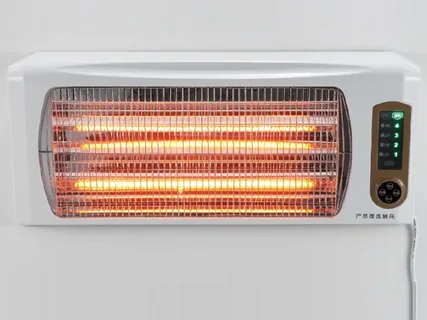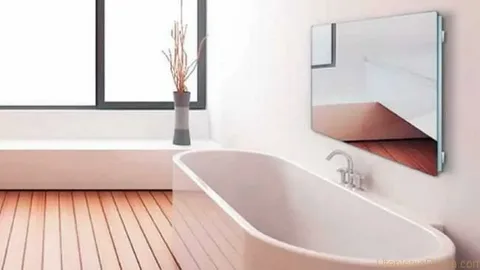Infrared bathroom heater is becoming increasingly popular as homeowners look for efficient ways to heat their homes during winter. These innovative heating solutions offer a range of benefits, from cost-effectiveness to improved energy efficiency. This blog post will explore the advantages of installing an infrared heater and how it can help you stay warm and comfortable throughout the colder months.
Introduction to Infrared Technology in Heating
Infrared heating technology operates by emitting infrared radiation, which objects and surfaces within a room readily absorb. This absorbed energy subsequently transforms into heat, warming the immediate environment. Distinct from traditional heating systems that heat the air via convection, infrared heaters target objects and individuals directly.
This method of heating not only ensures efficiency but also enhances the effectiveness of warmth distribution. Infrared radiation provides a direct source of warmth to people and objects in its path without the intermediary process of heating the air, leading to a quicker sensation of warmth.
The technology behind infrared heating represents a significant shift from conventional methods. It offers a unique approach to keeping spaces warm, focusing on direct, efficient heat transfer.
 Advantages Of Installing An Infrared Bathroom Heater Panel
Advantages Of Installing An Infrared Bathroom Heater Panel
One of the foremost advantages of opting for an infrared bathroom heater panel is its provision of immediate warmth. This is particularly beneficial in a bathroom where quick, efficient heating is paramount. Unlike traditional heating systems that require considerable time to raise the ambient temperature, infrared heaters begin to emit warmth the moment they are activated.
Another significant benefit is the energy efficiency inherent in infrared heating technology. These heaters directly warm objects and individuals in the room rather than the air. This direct method of heating ensures that no energy is wasted on heating unoccupied spaces, reducing energy consumption.
Additionally, the lack of air circulation with infrared heating reduces the movement of dust and allergens, providing a cleaner and healthier air quality within the bathroom. This aspect is particularly advantageous for individuals with allergies or respiratory issues, making an infrared heater a considerate choice for promoting a healthier home environment.
Understanding Infrared Heater Panels
Infrared heater panels represent a sophisticated and discreet heating option, favoured for their minimalistic appeal and efficiency in providing warmth. These panels, designed for either wall or ceiling installation, cater to a modern aesthetic whilst ensuring the space is heated effectively.
With various sizes and designs available, finding a panel that complements the interior decor of any bathroom is straightforward. These panels’ adaptability allows for seamless integration into existing design schemes, enhancing the overall look without compromising on functionality.
The operation of infrared -panels centres on emitting infrared radiation, which directly warms objects and surfaces in the room, offering an efficient heating method without needing to heat the air first. This direct heating approach contributes to the energy efficiency of these panels and maintains the integrity of the room’s air quality by minimising the circulation of dust and allergens.
Efficiency Of Infrared Home Heaters Compared To Conventional Heaters
Infrared home heaters excel in delivering immediate warmth upon activation, contrasting sharply with conventional heaters that may take longer to affect the ambient temperature of a room.
Targeted Heating
These heaters directly warm objects and individuals rather than the surrounding air. This precision avoids the inefficiency of heating unused spaces, a common drawback of traditional systems.
Energy Savings
Infrared heaters typically use less electricity than their conventional counterparts because they focus energy directly where needed, contributing to lower energy bills.
Eco-Friendly Operation
With lower energy consumption comes a reduced carbon footprint, making infrared heaters a more environmentally sustainable choice.
Healthier Air Quality
Infrared heaters do not circulate air within a room, which means they do not distribute dust or allergens. Thus, they maintain better air quality than conventional forced-air systems.
Durability and Maintenance
These heaters often boast a longer lifespan with minimal maintenance needs, enhancing their efficiency and appeal over traditional heating methods.
Infrared Heating System Contribute to a Healthier Home Environment
Infrared heating system play a significant role in fostering a healthier home environment. By directly leveraging the technology that heats objects and surfaces, these systems minimise air disturbance within a room. This approach is crucial in reducing the dispersion of dust, allergens, and other airborne particles, thereby presenting a cleaner and more breathable atmosphere.
Furthermore, infrared heaters’ ability to maintain optimal humidity levels is instrumental in mitigating the proliferation of mould and mildew. Such environments significantly benefit individuals suffering from allergies or respiratory conditions, offering them a more comfortable living space.
Moreover, the absence of forced air movement ensures a stable and consistent temperature, reducing drafts that often contribute to discomfort and health issues. Through these mechanisms, heating systems significantly contribute to the creation of a healthier and more inviting home environment without compromising on warmth or comfort.
Installation and Maintenance of Infrared Heating Panels
Installing infrared heating panels is notably simple and can typically be managed by homeowners. These units are designed for easy mounting on either walls or ceilings, accompanied by brackets that facilitate their secure attachment. Connection to the household’s electrical system is straightforward, as these panels are compatible with standard electrical outlets, eliminating the need for complex wiring procedures.
When it comes to maintenance, infrared heating panels require minimal effort. Regular cleaning, aimed at removing accumulated dust and debris from the panel’s surface, suffices in most cases. Such upkeep ensures the efficient operation of the panel, extending its service life and maintaining its heating efficacy.
Cost-Benefit Analysis Of An Infrared Home Heating System
While the initial cost of infrared home heating system might be higher than conventional heaters, their efficiency can result in significant long-term savings on energy bills.
Energy Efficiency
Infrared heaters convert almost all their energy into heat, resulting in lower electricity usage than traditional heating systems that may waste energy through inefficiency.
Minimal Maintenance Costs
With fewer moving parts than conventional heaters, infrared -panels typically have lower maintenance costs and avoid frequent repairs or replacements.
Durability
The lifespan of infrared heating panels often exceeds that of traditional systems, ensuring that the investment pays off over a longer period and reducing the need for early replacement.
Improved Health Benefits
Reducing the circulation of dust and allergens may reduce health-related costs, such as medications or doctor visits, for individuals with respiratory issues.
Environmental Impact
Infrared heaters’ reduced energy consumption contributes to lower carbon emissions, potentially saving costs related to environmental taxes or levies in the long term.
Tailoring Infrared Heating to Your Home’s Specific Needs
Heating systems offer a bespoke solution for heating requirements, adaptable to each home’s unique configuration. Homeowners can consult heating experts who can assist in crafting a tailor-made heating setup that aligns with their dwelling’s specific dimensions and layout.
This personalised approach ensures that every room receives the optimal level of warmth without the inefficiencies associated with standard heating models. A customised infrared heating plan can be developed by evaluating factors such as room sizes, insulation levels, and preferred temperatures.
This plan not only guarantees efficient heat distribution but also addresses any specific heating challenges presented by the home’s architecture. The flexibility of infrared technology allows for targeted heating solutions, ensuring that warmth is delivered precisely where it is most needed, enhancing comfort and maximising energy usage.
Infrared Panels for Whole-Home Heating Solutions
Infrared panels present a versatile and efficient option for heating not just bathrooms but the entirety of a home. These panels can be seamlessly integrated into any room, whether mounted on walls or ceilings, providing consistent warmth across various living spaces. The adaptability of infrared technology allows for a uniform heating experience, eliminating cold spots and enhancing comfort throughout the dwelling.
With designs catering to a broad interior aesthetic spectrum, these panels complement the decor while fulfilling heating needs. Homeowners benefit from the energy-efficient nature of these systems, which can lead to substantial savings on heating costs in the long run.
Additionally, the health advantages associated with reduced circulation of dust and allergens make infrared -panels an attractive choice for those prioritising air quality alongside thermal comfort. Through strategic placement and appropriate sizing, infrared heating panels can deliver a tailored heating solution that meets the specific requirements of every home, ensuring a warm and inviting environment during the colder seasons.
Environmental Impact of Switching to an Heating System
Adopting an infrared system presents an environmentally friendly alternative to conventional heating methods.
- These systems operate with greater energy efficiency, thus consuming less electricity and substantially reducing carbon emissions associated with household energy use.
- The direct heating mechanism inherent in infrared technology minimises waste, ensuring energy is used judiciously.
- This reduction in energy consumption directly translates to a lesser environmental footprint, aligning with the global movement towards more sustainable living practices.
- Moreover, the durability of infrared heaters contributes to less frequent replacements, curtailing the demand for manufacturing and the consequent resource depletion.
- By opting for an heating system, homeowners make a conscious decision that supports the preservation of the planet, endorsing technologies that offer both personal comfort and ecological benefits.
Conclusion
In conclusion, infrared home heating system stand out as a leading choice for those seeking to enhance the warmth and comfort of their homes during the colder seasons. With their reliance on cutting-edge infrared technology, these heaters offer many advantages, including but not limited to remarkable energy efficiency and superior air quality. The direct heating method in these systems ensures that warmth is felt almost instantly, setting them apart from conventional heating solutions. Furthermore, the minimal maintenance requirements and the aesthetically pleasing designs of infrared -panels complement modern living spaces whilst promising substantial savings on heating bills. The environmental benefits associated with reduced carbon emissions also underscore the role of infrared heaters in promoting sustainable living practices.
FAQs
How Long Do Infrared Heaters Last Compared To Traditional Heaters?
Infrared heaters typically have a longer lifespan due to their fewer moving parts and robust design. On average, they can last up to 20 years with proper maintenance, outperforming many conventional heating systems.
Can Infrared Home Heating System Heat A Whole House?
Yes, infrared home heating system can efficiently heat an entire house. A comfortable and uniform temperature can be achieved across all living spaces by strategically placing panels throughout different rooms and considering factors such as room size and insulation.
Are Infrared Heaters Safe To Use In Bathrooms?
Infrared heaters, especially models specifically designed for bathrooms, are safe for bathroom use. However, they must be installed according to the manufacturer’s guidelines and local building regulations to protect them from water ingress.a
| Other Good Articles to Read |
| niche blogs connect |
| blogs 97 |
| Blog Stitution |
| blogs unplugged |
| blogs cotch rouge |
| blog signatr |
| blog sintonias |
| blog zilla |
| consumer forums |
| finance forums |
| g blogs |
| too blog |
| Related Business Listings |
| Contact Directory |
| Local Business Profiles |



